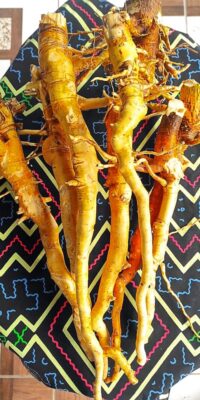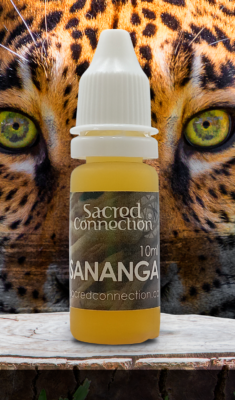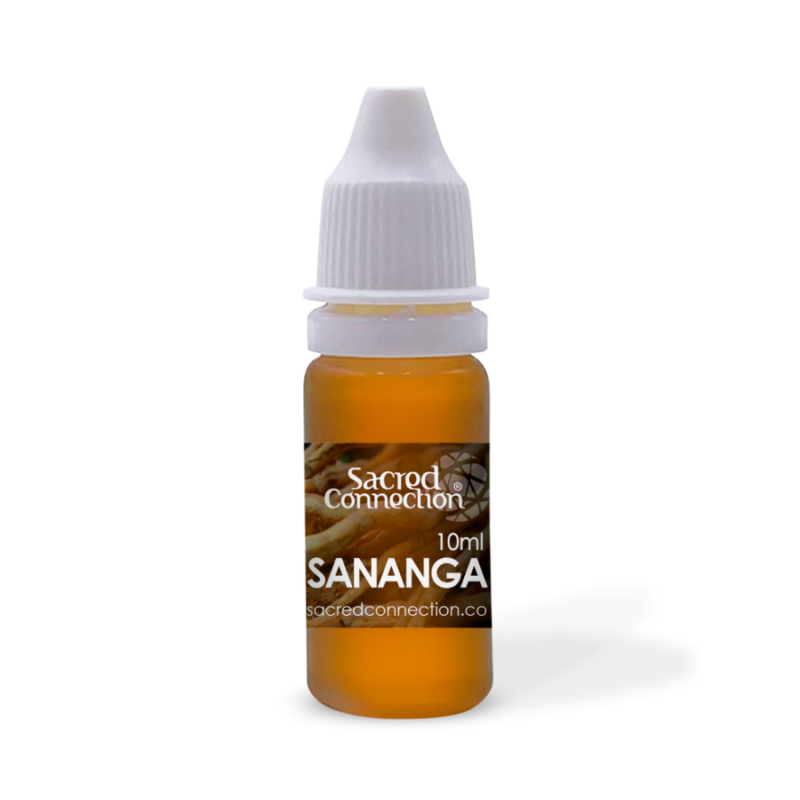The word ‘sananga’ refers to a number of different traditional eye drops used in some Amazonian cultures. Medicinal eye drops are used by Amazonian peoples such as the Matsés, Huni Kuin, Yawanawá and Ticuna for their wide-ranging healing properties, and as a source of spiritual exploration.
The reported benefits of sananga include the treatment of eye conditions and the improvement of visual acuity for hunting. It is used as an all-purpose remedy in some cases, to treat many different kinds of pains and diseases.
There are two main kinds of sananga – one uses the root bark from the Tabernaemontana sananho shrub, and another uses the root bark from Tabernaemontana undulata. Both plants have beautiful windmill-like flowers. The two kinds of sananga are usually differentiated; sananga made from T. undulata is called ‘mana heins’ by the Huni Kuin and ‘bechette’ by the Matsés.
The Spiritual Uses of Sananga
Taking sananga can be very painful – but this intense stinging in the eyes is related to its spiritual benefits. The pain indicates that the spirit of the plant is entering your body, distributing itself throughout your veins. The spirit of sananga can then help to remove negative or melancholic energies from your body (called panema).[1]
The spiritual and physical cleanse that sananga offers can be used in preparation for other plant medicines, and is a gentler purge than substances like kambo. Its effects on vision can also be used to sharpen visual experiences with psychoactive plant medicines.
Some people have reported that it is an excellent companion to ayahuasca, cleansing the spirit before the powerful ayahuasca purge, and enhancing the visionary experience of an hours-long ayahuasca ceremony.
Improving Visual Acuity with Sananga
Traditionally, sananga is often used before a hunt, to enhance the vision of hunters. The eye drops are not only thought to help them spot prey in the forest, but also allow them to hear with greater sensitivity and strike with more force. It is said that the improved power given to hunters after taking sananga can last for several days.[1]
Westerners also report that sananga can improve vision temporarily – describing vision as being sharper, experiencing deeper color perception, and having a higher tolerance for bright light.
While there is no research into sananga’s effects on visual acuity, its traditional use for this purpose is well-established, and Westerners consistently remark on its effectiveness.
Medicinal Properties
 Sananga is used traditionally as something of a cure-all. It has been used to treat wounds, illnesses, and diseases of all kinds.[1] Similarly, plants in the Apocynaceae family are used for various medicinal applications in different kinds of preparations throughout the Amazon, in addition to sananga eye drops.
Sananga is used traditionally as something of a cure-all. It has been used to treat wounds, illnesses, and diseases of all kinds.[1] Similarly, plants in the Apocynaceae family are used for various medicinal applications in different kinds of preparations throughout the Amazon, in addition to sananga eye drops.
Sananga is thought to contain a large number of alkaloids, although there have not been any thorough studies to determine the chemical composition of either T. undulata or T. sananho.
Sananga for Eye Conditions
Sananga has been used traditionally for centuries to treat eye conditions, or pains associated with the eyes such as headaches. Although there is not much science on the T. undulata or T. sananho plants, there has been some research into other plants in the Tabernaemontana sub-family…
Several studies have shown thatrent Tabernaemontana plants can attack some species of bacteria and fungus, suggesting that sananga could potentially help treat eye infections.[2-6] We are not yet sure what concentration of these plants would have a meaningful effect on an eye infection.
Some eye conditions, such as cataracts, are caused in part by inflammation. There is moderate evidence that sananga could reduce inflammation: several Tabernaemontana plants (including T. sananho) have been shown to reduce inflammation in mouse models of paw injury, and in molecular tests they can decrease levels of inflammatory compounds and have antioxidant effects.[6-11]
There is no evidence that sananga could be used to treat more serious conditions like glaucoma, or traumatic eye injuries. It could be dangerous to use sananga for these purposes.

How to Use Sananga
Sananga is best kept in the fridge to preserve its potency. When you’re ready to take sananga, it should be used carefully and with respect.
Prepare yourself and your space, and set a clear intention. Make sure you are somewhere comfortable and familiar, with no distractions. Have a large bowl of water ready to wash your eyes in case the stinging becomes too intense.
Lie back on the ground and close your eyes. Place one drop of sananga on the inside corner of your nose, where it meets your eye, on each side. This will allow you to open both your eyes at once and get an equal amount of sananga in each eye. Alternatively, ask a friend to help you distribute one drop into both of your eyes simultaneously.
Blink your eyes a few times to spread the sananga evenly. Breathe through the pain and try to remain present in your body, knowing that the experience will pass. Remember that the pain is crucial in allowing the sananga to heal, and remove negative energies from the body. The immediate stinging may last 10-15 minutes – wash your eyes in the bowl of water if it becomes too much.
Do not use sananga while you have contact lenses in, and don’t use contacts for at least a day following sananga use. If you are on any kind of eye medication, or have any kind of serious eye injury or open cuts around your eyes, check with your doctor before taking sananga.
Although some people find benefits from dosing with sananga in a regular schedule, we don’t know what the long-term effects of this might be. Stop taking sananga if you notice any changes to your vision or lasting pain/redness in your eyes.
References
[1] Shepard, Glenn (1999). Pharmacognosy and the Senses in Two Amazonian Societies. PhD Dissertation, University of California, Berkeley, Medical Anthropology Program. p102.
[2] Sathishkumar et al (2012). In vitro antibacterial and antifungal activities of Tabernaemontana heyneana Wall leaves. Journal of Applied Pharmaceutical Science 2(8), p107-111
[3] Marathe et al (2013). In vitro antibacterial activity of Tabernaemontana alternifolia (Roxb) stem bark aqueous extracts against clinical isolates of methicillin resistant Staphylococcus aureus. Annals of Clinical Microbiology and Antimicrobials 12(26), p1-8
[4] Van Beek et al (1984). Antimicrobially active alkaloids from Tabernaemontana pachysiphon. Phytochemistry 23(8), p1771–1778
[5] Suffredini et al (2002). Antibacterial activity of Apocynaceae extracts and MIC of Tabernaemontana angulata stem organic extract. Braz J Pharm Sci 38(1), p89–94
[6] Shrikanth et al (2014). Antimicrobial and antioxidant activity of methanolic root extract of tabernaemontana alternifolia. International Journal of Pharmacy and Pharmaceutical Sciences 7(1), p66-69
[7] Thambi et al (2006). Antioxidant and antiinflammatory activities of the flowers of Tabernaemontana coronaria. Indian Journal of Pharmaceutical Sciences 68(3), p352-355
[8] Taesotikul et al (2003). Anti-inflammatory, antipyretic and antinociceptive activities of Tabernaemontana pandacaqui Poir. J Ethnopharmacol 84, p31–35
[9] De las Heras et al (1998). Antiinflammatory and antioxidant activity of plants used in traditional medicine in Ecuador. Journal of Ethnopharmacology 61, p161-166
[10] Nicola et al (2013). Chemical Constituents Antioxidant and Anticholinesterasic Activity of Tabernaemontana catharinensis. The Scientific World Journal, DOI:10.1155/2013/519858
[11] Rumzhum et al (2012). Antioxidant and cytotoxic potential of methanol extract of Tabernaemontana divaricata leaves. International Current Pharmaceutical Journal 1(2), p27-31

